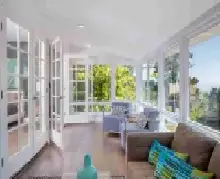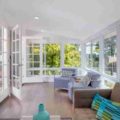Last Updated:April 07, 2024
How to soundproof your sunroom – (7 Easy Steps)

There are many reasons why people invest in sunrooms. For some homeowners, they provide a much-needed escape from the heat of summer; for others, they offer an additional living space to accommodate guests or for entertaining.
However, these rooms can also cause problems if you don’t take steps to soundproof them properly. Here are seven simple steps to ensure that your sunroom is not only beautiful but also quiet and comfortable when you want it to be.
Add Furniture to absorb sound in a sunroom
Adding furniture to your sunroom can help to reduce the sound in the room. For example, an ottoman with a thick, durable cover can be placed underneath a chair or sofa.
There are many reasons why people invest in sunrooms. For some homeowners, they provide a much-needed escape from the heat of summer; for others, they offer an additional living space to accommodate guests or for entertaining. However, these rooms can also cause problems if you don’t take steps to soundproof them properly. Here are seven simple steps to ensure that your sunroom is not only beautiful but also quiet and comfortable when you want it to be.
When you are adding furniture, you are going to get much more sound reduction with upholstered seating. We also like adding a few extra cushions to armchairs, couches or sectionals.
The pillows and padding in furniture padding will act as sponges that just soak up the sound waves.
If you have wood dining table and chairs, you can get some benefit from adding a table pad with a long flowing table cloth. Also, for the wooden chairs you can add some seat cushions. Both of these will provide minimal impact, but we’re including it because it can make a difference.
Use Heavy Area Rugs
We’ve seen a lot of other guides that recommend heavy carpet for for soundproofing a sunroom, but we do not. I think these posts are written by people who know a lot about soundproofing, but not nearly as much about sunrooms.
When you’re looking to sell the sunroom, the most desirable uses for potential buyers will be as a mudroom, an informal living area, or covered patio for hot tub or growing plants.
Installing carpet to any of these areas is a pretty big detractor for most homeowners, and they will either tolerate the carpet or just consider it something that needs to torn out so to add more appropriate flooring.
Also, sunrooms have a higher chance of collecting moisture which if it stays on the carpet can lead to mold and mildew. While some types of carpet are right for a sunroom, this type of carpet is *NOT* what you want for soundproofing.
If you’re considering carpet, we’ve written a full guide to flooring options for sunrooms.
While we are against heavy wall to wall carpet with heavy padding, an area rug can be a great option. Remember, you are simply looking for a material that will absorb the sound waves.
A textured area rug can greatly reduce the noise level of a room without making the room less desirable when you choose to sell it. Additionally textured area rugs can also be taken out to clean or dry in case of water damage to stop any mold damage.
Use curtains over windows in sunrooms to soundproof it.
Other ways to make this space soundproof is to install user curtains over the windows. This will help control the noise outside. It will also provide you with some privacy.
Soundproofing curtains are a great option because you can control the noise coming in, as well as sound coming out. They also provide an extra layer of insulation.
Your sunroom may not be the only place in your house that needs soundproofing. Consider adding panels to your door if you have one that opens into the room.
An easy way to tell if your sunroom needs soundproofing is by closing the door between it and the rest of the house and switching on a YouTube video on your phone at maximum volume. If the level of outside noise is not noticeably muffled inside, then it’s time to act.
Sound will bounce off flat surfaces which may cause it to reverb back into the room. Single pane glass is a terrible insulator of sound so anything that is not reflected back into the room just passes through the window as the glass vibrates.
For this reason, some type of window covering is absolutely essential for sound reduction. Our top choice is sound proofing curtains. These are made of thick heavy fabric that require a lot of energy to move back and forth.
If you are using the sunroom as a band practice area, streaming room, or theater room where the noise can go very loud, you may consider using moving blankets on curtain rods.
Actual soundproof curtains are without question the best, but they are less budget friendly. Uhaul and other truck rental companies will have used moving blankets for under $5-10 each.
The moving blanket solution is a bit of a hack because they are not something that I’d suggest leaving up 24/7, but they can do a fantastic job if you are just starting out and need to soundproof the room on a budget.
Seal Crack around doors and windows in a sunroom for soundproofing
Cracks between doors and windows can take a toll on the soundproofing of your sunroom. Sound will be able to enter the room from these cracks unless you seal them with foam or caulk.
For large cracks under a door, we suggest getting some weather stripping. These are very easy to install, and it will help with the overall energy efficiency of the room.
For smaller openings, we love using spray foam insulation. This is great at absorbing any soundwaves that get reach it. It also closes the hole that would have let the soundwaves simply pass through.
When it comes to spray insulation for soundproofing, we recommend spraying more than you need in the hole, and then you can carefully sand the excess off to even out the hole.
A side benefit of sealing all the cracks is that you will lessen the likelihood of getting insects, scorpions or snakes in your sunroom.
Don’t use permanent acoustic panels like soundproofing foam
We’ve seen several articles that suggested getting dedicated foam panels for sound proofing. We couldn’t disagree more with this suggestion.
These foam squares can be good for rooms that are mainly solid walls. It’s easy to create a large block of foam at the level of the speakers or talking in the case of a streaming room.
Sunrooms, however, will have windows at this level. The foam panels will have negligible affect when they are installed from under the window to the floor.
Furthermore, they will assuredly need to be removed before you sell the home, and their removal has been known to damage the underlying paint. It’s very likely that you’d need to repaint the walls after taking down these panels which didn’t really help with sound proofing.
You will see far more sound dampening from adding window treatments like curtains or the aforementioned moving blankets. Also, high quality soundproof curtains are going to be less expensive that getting the foam square tiles.
Use DIY sound dampening panels or artwork to soundproof a sunroom
There are some amazing videos on YouTube that talk about how to create sound proof panels with some old towels and small bits of lumber. These are ideal for sunrooms.
They can be hung on any solid wall. They are also lightweight that can be connected to a vertical stud without worry.
Add leafy plants along walls
A large potted plant in the corner of a room can have a noticeable impact on sound levels. When sound reaches a wall, it is reflected back to the source which causes echo or it passes through the material. Softer material will absorb some of the energy causing the sound levels to drop, but any decibels higher than what can get absorbed will just pass through the wall.
Large leafy plants virtually nothing for absorbing the soundwaves, but they do a great job at diffusing the sound waves. This means, the soundwaves will get deflected and hit the walls at different angles which will reduce energy transfer.
Furthermore, for soundwaves that are reflected back into the room, waves will have to pass through the plants a second time.
A few strategically placed large leafy plants will have a noticeable affect on noise levels.
Wrapping Up
There are many ways you can soundproof your sunroom. You could use DIY panels or homemade curtains, seal cracks around doors and windows with foam or caulk, add heavy area rugs to absorb some of the noise, and finally plant leafy plants along walls for further sound dampening effects. Which tips will you try first? Let us know if there’s anything we can do to help! We’re happy to provide a free consultation where our experts will walk through all these steps in detail so that you’ll be confident on how they work before implementing them into your home design.
In fact, we love to help with all your home improvement questions! We’ve written a complete guide to sunrooms.
As a reminder, we are just average homeowners who enjoy DIY home improvement projects. All posts on our site are for entertainment and general information purposes only.
If you have questions about your specific situation, we strongly suggest hiring a licensed contractor or construction professional who can analyze your precise situation and provide personalize solutions for you.



